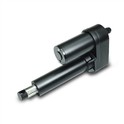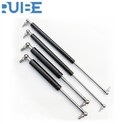As a seasoned supplier of Gas Damper for Car, I've witnessed firsthand the pivotal role gas dampers play in a vehicle's performance, especially at low speeds. In this blog, I'll delve into the intricate mechanisms of gas dampers and explore how they function under low - speed conditions.
Understanding Gas Dampers in Cars
Gas dampers, also known as shock absorbers, are a critical component of a car's suspension system. Their primary function is to control the movement of the vehicle's springs and suspension. When a car encounters a bump or pothole, the springs compress and expand to absorb the shock. However, without gas dampers, the springs would continue to oscillate, causing the car to bounce uncontrollably. Gas dampers work by converting the kinetic energy of the bouncing springs into heat energy, which is then dissipated into the atmosphere.
The basic structure of a gas damper consists of a cylinder filled with hydraulic fluid and a piston. The piston has small holes or valves that allow the fluid to flow through when the damper is compressed or extended. As the fluid passes through these valves, it creates resistance, which slows down the movement of the piston and, in turn, the movement of the springs.
Performance at Low Speeds
At low speeds, gas dampers face a unique set of challenges and requirements. Unlike high - speed driving, where the dampers need to handle large and sudden impacts, low - speed driving involves more frequent but smaller movements.
Smooth Ride
One of the key performance aspects at low speeds is providing a smooth ride. When a car is moving slowly, every little bump or imperfection on the road can be felt more acutely. Gas dampers with proper valve settings can effectively absorb these small shocks, preventing them from being transferred to the vehicle's cabin. For example, when driving over a speed bump at a low speed, a well - functioning gas damper will ensure that the car passes over it smoothly, without a jarring impact.


Steering Response
Low - speed steering response is also influenced by gas dampers. When a driver turns the steering wheel at a low speed, the suspension system needs to react quickly to maintain stability. Gas dampers help to control the roll and pitch of the vehicle during steering maneuvers. They ensure that the tires maintain proper contact with the road surface, which is crucial for accurate steering. A car with well - calibrated gas dampers will have a more precise and responsive steering feel at low speeds, making it easier to navigate through tight spaces such as parking lots.
Comfort and Noise Reduction
Comfort is a top priority for many car owners, especially during low - speed city driving. Gas dampers play a significant role in reducing noise and vibration inside the vehicle. By absorbing the shocks and vibrations from the road, they prevent them from reaching the car's body and interior. This not only makes the ride more comfortable but also reduces the overall noise level. For instance, when driving on a cobblestone street at a low speed, a good gas damper can significantly reduce the rattling and noise that would otherwise be transmitted to the passengers.
Factors Affecting Low - Speed Performance
Several factors can affect the performance of gas dampers at low speeds.
Valve Design
The design of the valves in the gas damper is crucial for low - speed performance. Valves need to be calibrated to allow for smooth fluid flow at low velocities. A damper with too much resistance at low speeds will make the ride feel harsh, while a damper with too little resistance may not provide enough control. Manufacturers spend a great deal of time and resources optimizing the valve design to achieve the perfect balance between comfort and control at low speeds.
Fluid Viscosity
The viscosity of the hydraulic fluid in the gas damper also plays a role. At low temperatures, the fluid can become more viscous, which can affect the damper's performance. In cold weather, a damper with a high - viscosity fluid may take longer to respond to small movements, resulting in a less smooth ride. Therefore, many modern gas dampers use fluids with a low - temperature viscosity index to ensure consistent performance in all weather conditions.
Mounting and Installation
Proper mounting and installation of the gas damper are essential for optimal performance. If the damper is not installed correctly, it may not function as intended, especially at low speeds. Incorrect mounting can lead to misalignment, which can cause uneven wear on the damper and affect its ability to absorb shocks. It is important for car owners to have their gas dampers installed by a professional to ensure proper function.
Comparing with Other Types of Dampers
In the market, there are other types of dampers available, such as Cabinet Gas Damper used in non - automotive applications. While the basic principle of gas dampening is similar, the requirements for car gas dampers are much more demanding, especially at low speeds.
Cabinet gas dampers are designed to control the movement of cabinet doors and drawers. They typically operate at much lower forces and speeds compared to car gas dampers. The valve settings and fluid requirements for cabinet gas dampers are optimized for their specific applications, which are very different from the high - stress environment of a car's suspension system.
Car gas dampers need to handle a wide range of forces and movements, from the small vibrations at low speeds to the large impacts during high - speed driving. They are also exposed to more severe environmental conditions, such as dirt, water, and extreme temperatures. Therefore, the engineering and design of car gas dampers are more complex and sophisticated to ensure reliable performance at all speeds.
Improving Low - Speed Performance
As a gas damper supplier, we are constantly working on improving the low - speed performance of our products.
Advanced Materials
We are exploring the use of advanced materials in the construction of gas dampers. For example, using lighter and stronger materials for the piston and cylinder can reduce the overall weight of the damper, which can improve its responsiveness at low speeds. Additionally, new materials can also offer better resistance to wear and corrosion, ensuring a longer service life.
Smart Damper Technology
The development of smart damper technology is another area of focus. Smart dampers can adjust their damping characteristics in real - time based on various factors such as vehicle speed, road conditions, and driving style. At low speeds, these dampers can automatically optimize their settings to provide a smoother and more comfortable ride. For example, if the car is driving on a rough city street at a low speed, the smart damper can increase its damping force to better absorb the shocks.
Conclusion
In conclusion, gas dampers for cars play a vital role in ensuring a smooth, comfortable, and safe ride, especially at low speeds. Their performance at low speeds is influenced by various factors such as valve design, fluid viscosity, and mounting. By understanding these factors and continuously improving our products, we can provide gas dampers that meet the high - standards of modern car owners.
If you are in the market for high - quality gas dampers for your cars, we would love to have a conversation with you. Our team of experts can provide you with detailed information about our products and help you choose the best gas dampers for your specific needs. Whether you are an automotive manufacturer or a car enthusiast, we are here to assist you in enhancing the performance of your vehicles. Feel free to reach out to us to start the procurement and negotiation process.
References
- Smith, J. (2018). "Automotive Suspension Systems: Principles and Design". Publisher: ABC Publishing.
- Johnson, M. (2020). "The Science of Shock Absorbers". Journal of Automotive Engineering, Vol. 35, Issue 2.
- Williams, R. (2019). "Advanced Materials in Gas Damper Technology". Proceedings of the International Conference on Automotive Technology.






